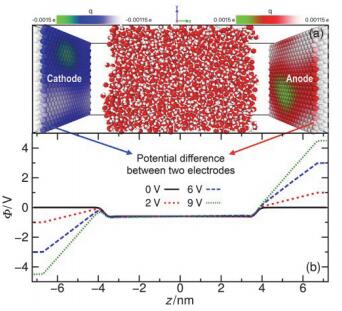摘要/Abstract

水表面电势在诸多电化学过程与反应中扮演关键角色, 然而实验上直接测量却极具挑战. 本论文提出一套基于平衡态恒定电势分子动力学的模拟-分析-计算方法, 可实现通过保持恒定电势且伴随电荷涨落的电极板将电场作用于附近的水表面, 并以平均探针电势计算方法精确测量空间电势分布. 凭借此套方法, 首次计算了不同电极电势下水表面区域的空间电势分布函数, 并测得了鲜有报道的水表面电势随外电场的变化关系. 发现了阴极附近水的表面电势随外电场增强而降低而阳极附近水的表面电势随外电场增强而增大的非对称性. 同时计算了平衡态水表面分子数密度和偶极矩极化密度分布函数, 展示出逐渐增强的外电场能够强烈改变水表面区域的极化行为也能够使液体水整体微弱的极化. 论文最后提出水表面电势随电场变化的非对称性源自水表面极化行为的非对称性以及液体区域的整体极化.
关键词: 水, 分子动力学, 恒定电势法, 液-汽界面, 平均探针电势计算法
The surface potential of the liquid-vapor interface of water plays a critical role in electrochemistry, interfacial reactivity, and solvation thermodynamics. However, direct experimental measurement of the surface potential of pure water is exceedingly challenging. Here we present a methodology to explore the effect of external electric field on the water surface potential. The methodology contains constant electrostatic potential molecular dynamics simulation[J. Chem. Phys., 126, 084704(2007)], in which, the electrode charges are allowed to fluctuate to keep the potential fixed, as well as a recently developed probe and average method[J. Phys.: Cond. Matter, 28, 464006(2016)] to accurately map out the electrostatic potential across the water surfaces. The methodology is applied to the coexistence of the vapor phase and the liquid phase of the room temperature pure water (described by a simple SPC/E water model) under different magnitudes of E-fields generated from the nearby electrodes, yielding a first-time calculation of the external E-field dependent water surface potential profiles, and the relationship between the water surface potential and the external E-field strength which has been rarely reported. We found an asymmetric effect of external E-field on the surface potential, i.e., the surface potential decreases with increasing the external E-field strength for the water surface close to the cathode, while the surface potential increases with increasing field strength for the surface close to the anode. The water surfaces are also characterized by calculating the number density and dipole polarization density profiles, which depict the presence of the external E-fields induced bulk polarization under high strength field. By comparing the dipole polarization density profiles and the potential profiles, we conclude that the asymmetric effect of external E-field on the surface potential is due to the asymmetric behavior in surface polarization under external E-field for the water surfaces near cathode or anode, and is also due to the polarization within bulk part of the liquid water. The methodology presented in the current study can be easily applied to more advanced water models such as polarizable water models which are beyond the SPC/E used in current work. The achievement of the fundamental data and the physics relationship between the surface potential of water and the applied external E-field could potentially facilitate the advancements in electrodynamics and thermodynamics of the liquid-vapor interfaces.
Key words: water, molecular dynamics, constant potential method, liquid-vapor interface, probe and average potential calculation method
PDF全文下载地址:
点我下载PDF
